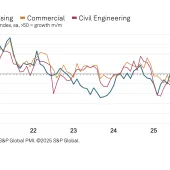The Market – Where Now?

Assessing prospects for the quarrying industry
By Julian Clapp, chief executive of BDS Marketing Research Ltd
In recent years, demand for heavy building materials has apparently been able to defy gravity in the face of increasing private and public debt. Even without the sub-prime crisis and credit crunch, it seems implausible that house prices could have continued to rise. A correction was inevitable. However, the wider economic problems have made a difficult position much worse. Reductions in mortgage lending have made the recession deeper in house building, while lower demand has also affected the industrial and commercial sectors.
The first sign of falling building materials markets occurred in March 2008 with volumes in aggregates and ready-mixed concrete down by 10%. The industry is still grappling 12 months later with volumes that are now 20% down on 2007.
The critical consideration now is to forecast the market over the next few years. This article assesses the factors that are influencing demand for aggregates, asphalt and ready-mixed concrete, and the likely course of the market until 2012.
There are no accurate figures available on the end use of heavy building materials. The figures will also vary year on year, but the accompanying charts reflect the relative importance of the main markets. Just over a half of aggregates are used in roads and other publicly backed schemes. Ready-mixed concrete has a more even split between housing, industrial and commercial, and public work, while around 80% of asphalt is destined for infrastructure.
In the current downturn, the asphalt market has been less affected than aggregates or ready-mixed concrete. Demand from public sector projects has remained relatively buoyant, which has helped to sustain asphalt demand. However, the number of new roads let recently has fallen, so asphalt sales have begun to decline. Lower house building has affected demand for aggregates and, particularly, ready-mixed concrete. In 2008, volumes of aggregates fell by 13%, ready-mixed concrete by 14%, with asphalt demand down by just 3%. It is health, education and other public schemes that are maintaining the concrete market. If this sector had to rely solely on private housing, industrial and commercial work, sales would be more than 30% down over the last two years.
A comparison with previous recessions makes interesting reading. Although the current recession has only been in existence for just over a year, it is already on a par with other periods in terms of the decline in output. In addition, whereas previous recessions came after periods of strong growth, the current decline is after a period of little or no growth. By the end of 2009, the current recession will have been the worst since before 1945.
Many existing trends are working in opposite directions, making forecasting more difficult than normal. Optimists will quote rising population (likely to increase from 61 million in 2008 to at least 69 million by 2051), increasing immigration, government fiscal policy, low interest rates, an improvement in the affordability of homes index and the influence of major projects, including the 2012 Olympics, 2014 Commonwealth Games (contracts now going out to tender), planned nuclear power schemes and other infrastructure projects.
The pessimists can point towards the difficulty of obtaining credit, rising unemployment and the threat of losing jobs, falling house prices and rising levels of personal and government debt.
The key to predicting materials demand is to analyse the early warning indicators. Since the housing market was the first to decline (as in most previous recessions), it is reasonable to believe that this sector will be the first to recover. Before house builders start building more houses, companies need to be selling their existing stock and seeing more potential buyers. Information collected by the Royal Institution of Chartered Surveyors shows that the sales-to-stock ratio has now stabilized at a lower level. More potential buyers are now being reported, although they may be window shopping in some cases; mortgages still have to be arranged. However, these figures would suggest that the bottom of the housing market may have been reached. According to the Council of Mortgage Lenders, mortgage approvals started to fall at the end of 2006, some 12 months before the recession started. Approvals are now at around 30,000 a month. This is less than half the level of a year ago, but approvals have started to stabilize at this lower level. While the leading indicators suggest that the housing market has stabilized, it is too early to suggest a recovery.
House prices have fallen by around 20%. Recent evidence suggests that prices may be stabilizing but it will take more than one month’s figures to be conclusive. A further smaller drop can be expected until the middle of next year. This will mean that the housing market is likely to remain subdued for a further 12 months. Another indicator which suggests that the market might begin to recover during 2010 is the current state of the US housing market. This started to fall around a year before the UK. February 2009 saw the first signs of recovery in the US, with housing starts higher by 20%. A similar time lag in UK recovery could occur, which, again, would suggest recovery in the UK housing market in 2010.
Even when house builders were building over 200,000 houses a year there was talk that this was insufficient to meet the country’s needs. In 2008, the number of starts fell to 124,000. In the current year, starts are expected to fall again to just 80,000. It seems inconceivable that starts can go much lower. Nearly a half of housing starts are now carried out by the public sector and the Government has stated its commitment to this sector.
The current level of government debt is close to 1976 levels when the Government had to apply to the International Monetary Fund (IMF) for additional funding. At over 10% of GDP, debt is higher than some countries that have already received assistance from the IMF in the current recession. Debt levels will deteriorate further. Lower levels of economic activity will affect tax revenues. Higher unemployment will increase government expenditure.
Recent changes in government policy will take time to influence the economy. The policy of quantitative easing, low interest rates and increased short-term government expenditure are all geared to aid recovery. Once these take effect, the Government will be faced with a different set of dilemmas – increasing prices, higher government debt and rapid economic recovery. These are not concerns at the moment. However, this does show that the country faces many years of uncertainty before a degree of stabilization is achieved.
Since the mid-1990s, demand for heavy building materials has rarely changed by more than 5% year on year. It could be many years before producers can again budget with the same degree of certainty. Once the economy picks up, the Government will have to reduce its debt burden and increase interest rates. This will include reducing public expenditure, which will hit the asphalt market in particular. The author’s view is that soon after the housing market starts to recover in 2010, the Government will have to restrain policy, to avoid problems of an overheating economy. A recovery in the private sector will offset the forecast decline in the public sector – the opposite of the current situation.
Sales of building materials have gone lower in 2009. However, as the year progresses, comparisons with 2008 will show an apparent improvement as the market deteriorated badly towards the end of last year. Any such improvement should be seen as one of a situation not getting worse, rather than one of recovery. BDS are forecasting a further 16% drop in ready-mixed concrete volumes during 2009. A slightly smaller fall in aggregates volumes is expected, owing to the sector’s greater reliance on the more buoyant infrastructure sector. Asphalt demand is likely to fall by up to 10% in the current year.
Although there is little evidence of an actual recovery in housing at the moment, current building levels are so low that it would not take much to see some improvement. Housing starts of 100,000 in 2010 would still be less than half of recent levels. However, this would represent an increase of 20% on the expected out-turn, in 2009. The industrial and commercial building sectors are likely to have a difficult year during 2010. A number of major schemes started in more prosperous times are now being completed and will not be replaced by projects of a similar size. Major commercial schemes can take many years to complete, whereas housing schemes change more quickly in line with events. This will dampen the expected increased demand for materials in housing. BDS Marketing Research do not expect to see any significant recovery in ready-mixed concrete demand until Spring 2010, but by the end of that year, volumes could be noticeably higher. For 2010 as a whole, the consultancy’s forecast is for an increase of 6% in the ready-mixed concrete market. Some growth is also expected for the following two years.
Public expenditure on local road maintenance provides a base load of work for asphalt. However, the major determinant of changes in demand is the construction of new road schemes and major surfacing projects. For example, in 2007 the total asphalt market was similar to the previous year. However, one region saw volumes increase by 10%, while another region saw the market drop by 9%.
As the majority of asphalt is required towards the end of the project, monitoring of road schemes can provide a forecasting tool. Most of the major road schemes planned by the Highways Agency over the next year are based in the South East (M1 and M25 improvements), with the A1 motorway upgrade likely to be the largest contract in the north. After 2011, the emphasis will switch to motorway resurfacing around Manchester, Leeds and Birmingham. The Government has stated its priority in getting infrastructure projects started, so schemes planned to start shortly are likely to do so. However, there has been a long-term problem over scheme deferral and cancellation. The progress of schemes after 2011 cannot be guaranteed, as government finances will be under pressure at this time. Asphalt demand is expected to increase slightly in 2010 with a more pronounced recovery in 2011. However, cutbacks in government expenditure are expected from the end of 2010, leading to a decline in asphalt demand from 2012.
As nearly one third of aggregates are used in asphalt and concrete production, trends in the latter markets have an important impact on the demand for aggregates. Aggregates markets are expected to increase by around 4% in 2010 with more subdued growth in each of the following two years.
These forecasts might appear optimistic in the current climate. However, BDS projections for 2012 still show markets typically 15% lower than in 2007.
It would appear that the country will be spending most of the next decade paying off the debts being incurred at the moment. Longer-term forecasts are for limited growth. Full recovery back to 2007 levels should not be expected in the medium term. Companies need to be aware of this in their forward planning.
During the late 1980s, the major companies had become bloated from high demand. Many companies could cut back operations in the early 1990s, while still maintaining a major presence in all of the main markets. This is more difficult in the current recession. Already, asphalt plants in operating quarries have been closing. While this might stem any losses on asphalt, the quarry will have lost a major customer. A similar situation has been occurring through the closure of ready-mixed concrete plants. Some companies are no longer represented in particular towns, with the nearest concrete plant now being too far away to be competitive. Smaller companies with just one operation appear to have little option but to move to short-time working.
For the top five aggregates companies, strategy will be at two levels. At national level, business plans will include assessing the options of disposing of peripheral assets. Over the past decade, many of the major players have already sold off most of their non-core assets, such as concrete products works and industrial minerals. Further asset disposals are now likely to be geographical in nature, in areas such as Scotland or the South West. Closures are likely to be isolated asphalt or concrete plants, or loss-making quarries. Many of these cannot really be regarded as ‘non core’. In previous recessions, closure of an operation would be balanced by picking up sales from another site nearby. This may not now be the case, as the next operation may be too far away. This is a downward spiral from which it can be difficult to escape. The leading companies are now international businesses. At group level, each company will be assessing those countries which it may consider exiting from in total.
Companies with cash in the bank will weather the storms better. They will also be able take advantage of any industry fire sales. One of the likely consequences of this recession is that the market shares of some small companies will begin to increase. This will reverse the trend seen for many years. At the present time, it appears that sellers are looking at valuations when the market was a lot higher. This will change over time as profits continue to fall. It will take a company with a strong will to invest in the current climate, yet this could provide the greatest benefits in the long term. More deals are expected once recovery is under way.
Since the beginning of 2008, the industry has been faced with what can euphemistically be called interesting times. The next two years will be just as interesting. At least the market will begin to recover before not too long. This will allow companies to plan with more confidence for their long-term future.








